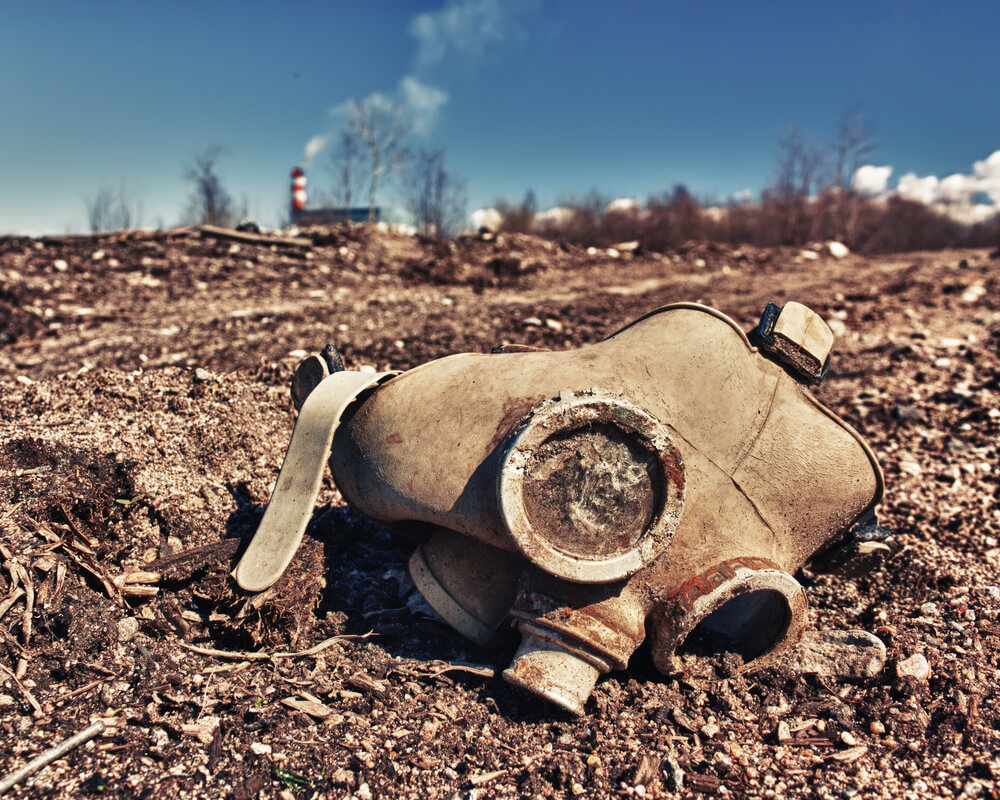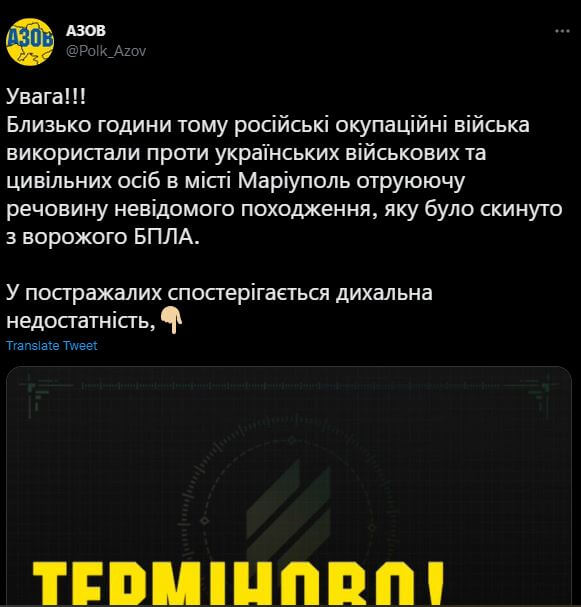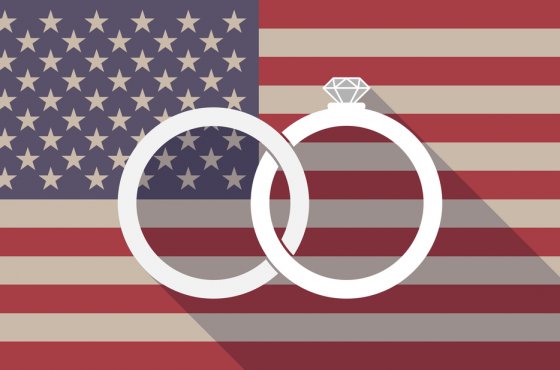Respiratory failure and vestibulo-atactic syndrome: Russians used chemical weapons in Mariupol
Russian invaders used chemical weapons against the defenders and residents of Mariupol, reports censor.net.

Photo: Shutterstock
The Russian invaders carried out their threats and used chemical weapons against the defenders and residents of Mariupol.
The Azov regiment reported this on Twitter.

Photo: Twitter Azov Regiment
The report notes: “About an hour ago, Russian occupation forces used a toxic substance of unknown origin, which was dropped from an enemy UAV, against Ukrainian military and civilians in the city of Mariupol. The victims are experiencing respiratory failure."

Photo: Twitter Azov Regiment
Convention
Ironically, chemical weapons were banned even before their use, which did not prevent their use in the First and Second World Wars. Banned due to great inconvenience of use. It strongly depends on weather conditions, in the event of a change in wind direction, civilians or even their own troops may suffer. Also, the development of protection against RH has led to a decrease in its effectiveness. And the storage of such substances is very expensive and unsafe. All European countries, including Russia, and the United States agreed to sign a convention banning the production and use of chemical weapons.
On the subject: The EU has banned flights of 21 Russian airlines: their planes are recognized as unsafe
The Convention on the Prohibition of the Development, Production, Stockpiling and Use of Chemical Weapons and on Their Destruction (CWC) was opened for signature by the UN Secretary-General in Paris on 13 January 1993 and entered into force on 29 April 1997. RIA News.
The Chemical Weapons Convention is the world's first multilateral disarmament agreement to eliminate an entire class of weapons of mass destruction within a specified time frame.
The Convention is aimed at solving two major problems. The first is the elimination of a whole class of dangerous types of weapons of mass destruction under strict international control (disarmament), the second is the prohibition of the production and use of chemical weapons (prevention of their proliferation). The convention is perpetual.
There are currently 192 States parties to the CWC. Russia, which had the largest stocks of chemical weapons in the world - 40 tons, became a full party to the Convention on December 5, 1997.
The Parties to the Convention undertake not to develop, produce, otherwise acquire, stockpile or retain, transfer, use chemical weapons or conduct military preparations for their use; assist, encourage or induce in any way anyone to violate the Convention; not use chemical riot control agents as a means of warfare.
To monitor the implementation of the Convention, the States Parties established the Organization for the Prohibition of Chemical Weapons (OPCW), its headquarters are located in The Hague, the Netherlands. The OPCW is also an international platform for discussing all issues related to the implementation of the Convention.
Albania, Libya, Iraq, India, Russia, the United States, the Republic of Korea and Syria have officially recognized the presence of chemical weapons.
In accordance with the provisions of the Convention, all stockpiles of chemical weapons in the world were to be destroyed 10 years after its entry into force, on April 29, 2007. By decision of the participating States, this period could be extended up to 15 years - until April 29, 2012.
Three countries have already completed their chemical disarmament programs - Albania in 2007, Korea in 2008, India in 2009.
Due to the fact that the three possessor states (Russia, the United States, Libya) were unable to complete the destruction by April 29, 2012, at the 16th session of the Conference of States Parties to the CWC, a decision was made giving these countries the right to designate the shortest possible time for the complete destruction of their stockpiles of chemical weapons.
Russia announced December 31, 2015 as the end date for its chemical disarmament program, the United States - September 30, 2023, Libya - December 31, 2016.
Russia said that as of the end of 2016, it had destroyed about 96% of all available stocks.
The United States, which had stocks of 31,500 tons of toxic substances (was the second largest owner of chemical weapons stockpiles), joined the Convention on April 29, 1997 and by the end of 2016 eliminated about 90% of stocks of toxic substances.
Consequences of use
Chemical weapons proved to be excellent at the very beginning of its use. This was the beginning of the First World War, reports Yandex Zen. The Germans were advancing on the united front of the British and French. The latter were on the defensive when they noticed a strange greenish-yellow cloud moving towards them. When it reached the front ranks, the fighters began to fall one by one, clutching their throats. It was chlorine. At that moment, 5 thousand people died at once. Another 10 remained wounded. The Germans took the fortifications without a fight.
You may be interested in: top New York news, stories of our immigrants, and helpful tips about life in the Big Apple - read it all on ForumDaily New York.
From that moment on, all parties to the conflict began to develop and use poisonous weapons. There is a division of toxic substances (OS) into:
- Nerve paralytic (sarin, tabun), affect the nervous system, paralyze a person and lead to death due to asphyxia (suffocation) or cardiac arrest. May enter the body through the respiratory tract or skin.
- Asphyxiants (chlorine, phosgene) lead to pulmonary edema, accumulation of fluid in them and subsequent death from suffocation.
- Skin-blisters (mustard gas), acts not only by breathing, but also by contact with the skin. Causes skin ulcers, pneumonia. For protection, you need an airtight suit, and not just a gas mask.
- The general effects (hydrocyanic acid) are the fastest in terms of time of action. It does not allow the cells of the body to absorb oxygen, as a result of which the very first to die are nerve cells (most in need of oxygen). Death from cardiac arrest.
Read also on ForumDaily:
Ukrainian swam 4 km in icy water to escape Russian torture in Mariupol
Subscribe to ForumDaily on Google NewsDo you want more important and interesting news about life in the USA and immigration to America? — support us donate! Also subscribe to our page Facebook. Select the “Priority in display” option and read us first. Also, don't forget to subscribe to our РєР ° РЅР ° Р »РІ Telegram and Instagram- there is a lot of interesting things there. And join thousands of readers ForumDaily New York — there you will find a lot of interesting and positive information about life in the metropolis.











